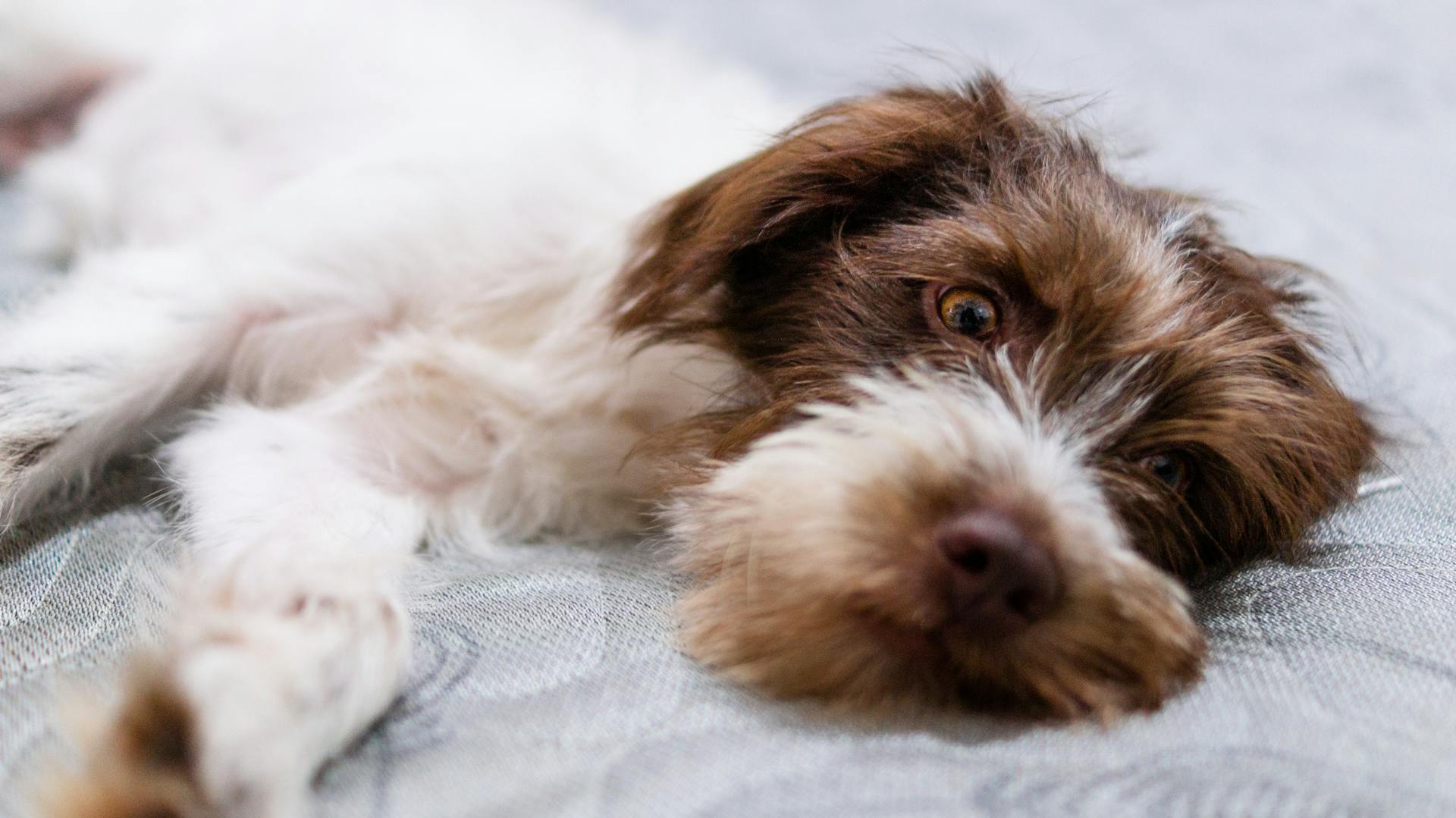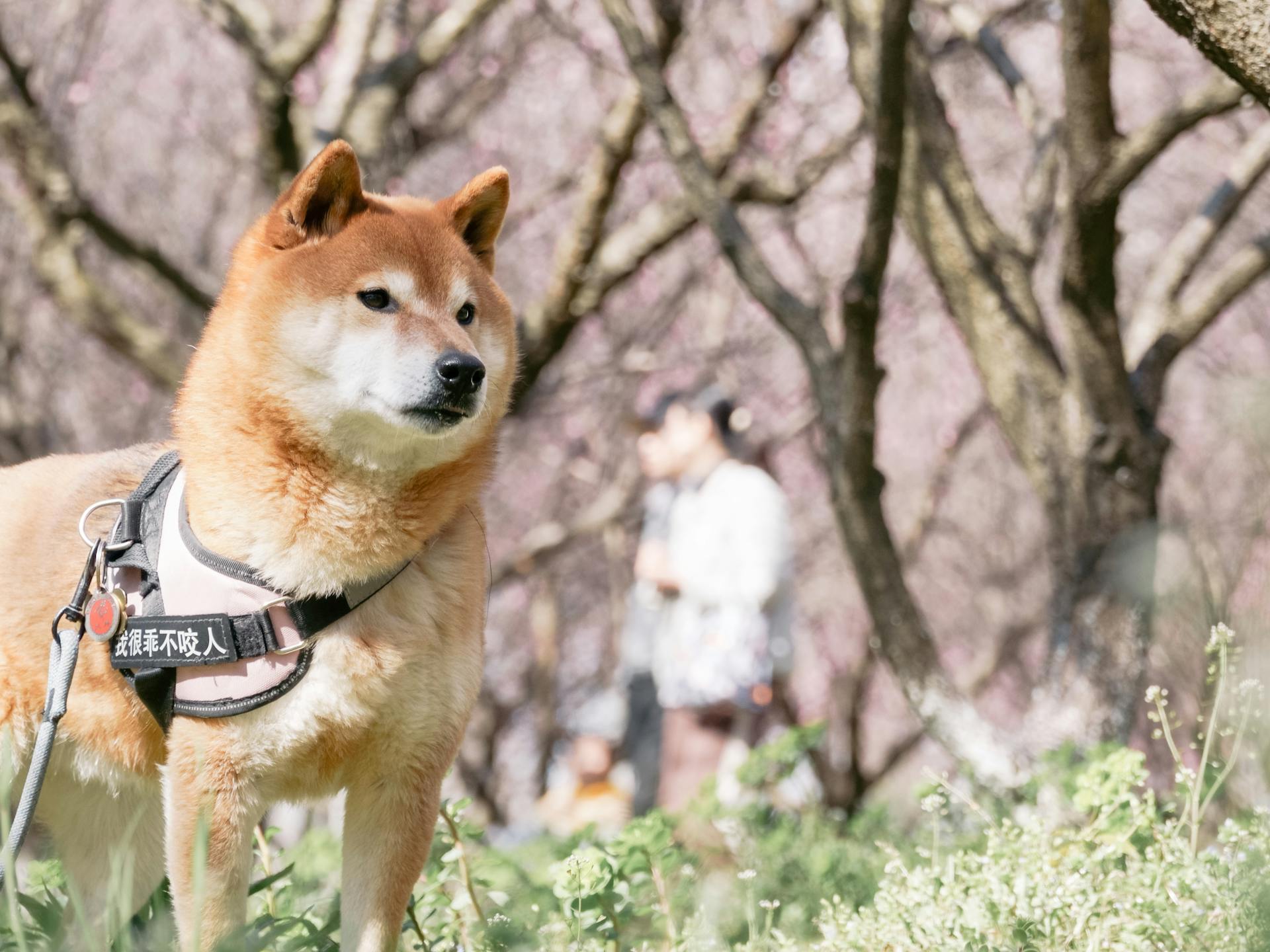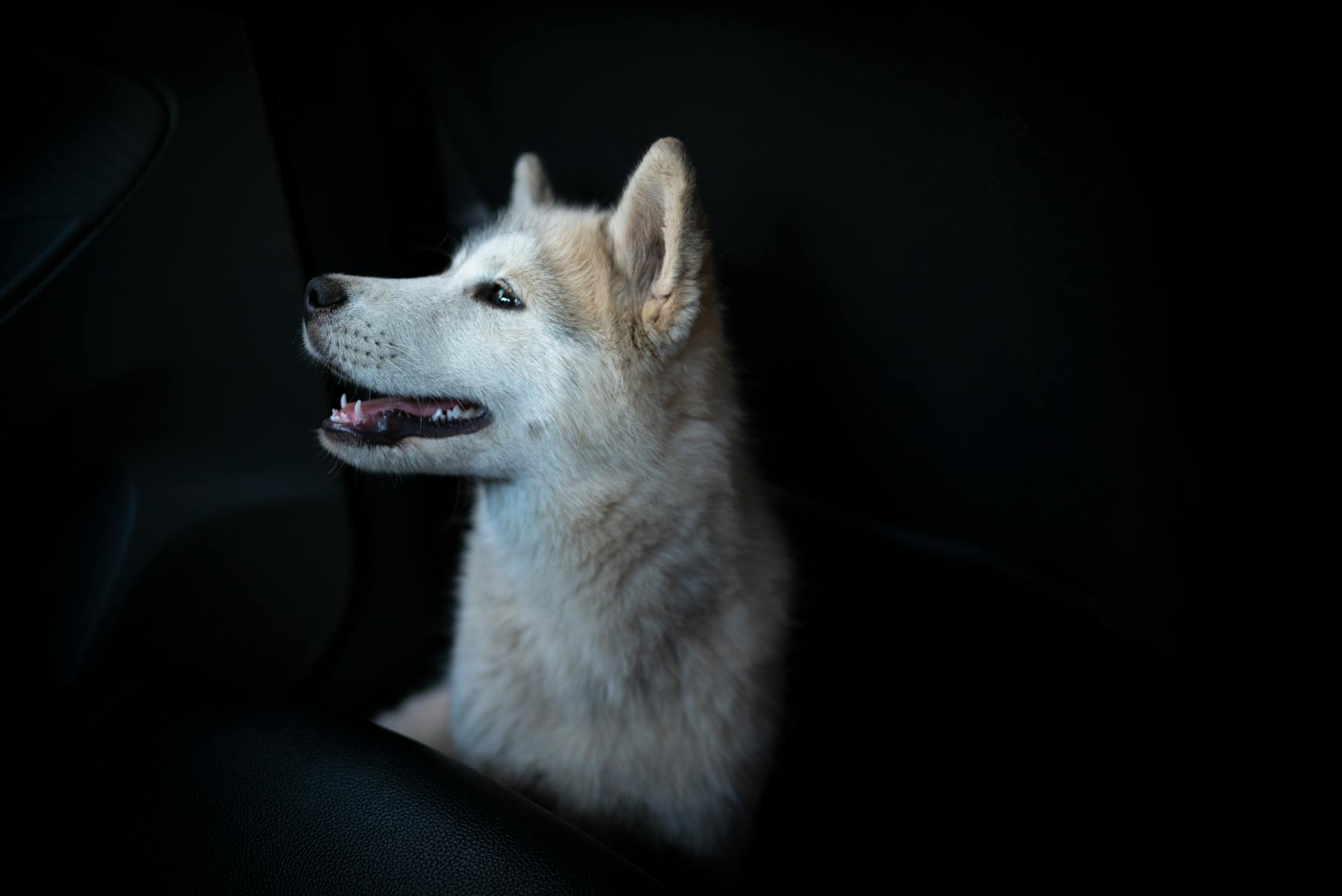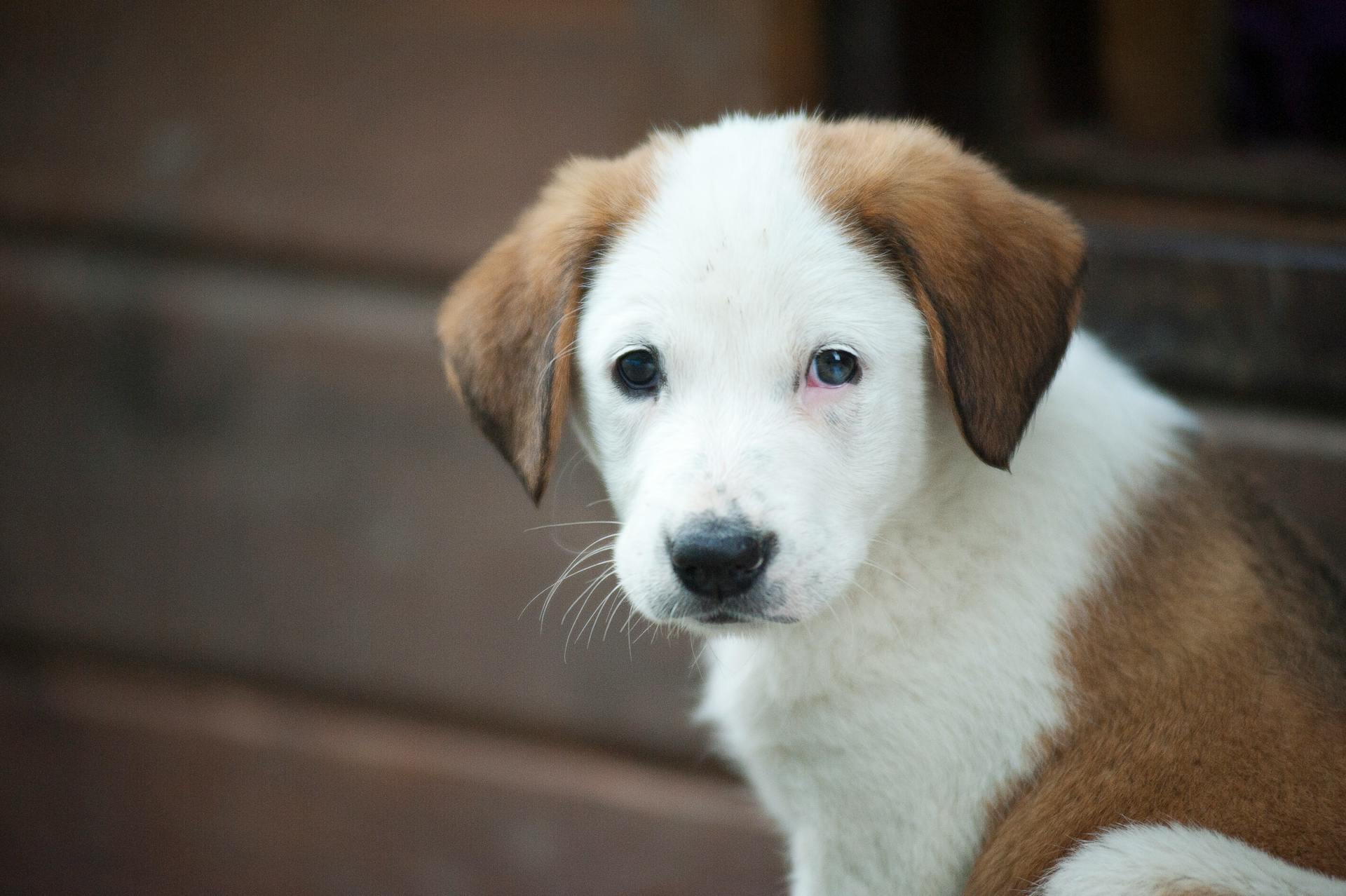
F1 Labradoodles are a popular mixed breed, but what does that even mean? They're a cross between a Labrador Retriever and a Poodle, specifically an F1 Labradoodle, which stands for "first generation" or 50% Poodle and 50% Labrador.
Labradoodles are often considered one of the most intelligent breeds around, thanks to their Poodle parent's high IQ. They're known to be highly trainable and eager to please their owners.
In terms of grooming, F1 Labradoodles inherit their Poodle parent's low-shedding coat, making them a great choice for those with allergies or who prefer less dog hair.
What is a Labradoodle?
A Labradoodle is a crossbreed dog that combines a Labrador Retriever with a Poodle, typically a Standard Poodle.
Labradoodles were originally bred in the 1980s to create a hypoallergenic guide dog for people with allergies.
They are often considered a hybrid or designer breed.
Labradoodles can vary in size, but F1 Labradoodles tend to be medium to large in size, weighing between 50-90 pounds.
Labradoodles are known for their intelligence and trainability, making them a popular choice as family pets and working dogs.
Their low-shedding coat requires regular grooming to prevent matting and tangling.
Labradoodles are often used as therapy dogs, search and rescue dogs, and service dogs due to their intelligence, loyalty, and affectionate nature.
Physical Characteristics
F1 Labradoodles have a sturdy and well-proportioned body, inheriting the strong build of the Labrador Retriever combined with the Poodle's more refined, slender features. Their strong chest complements their athleticism.
Their eyes are round and can be brown or hazel. Floppy ears are typical, although some may be pendant-shaped like the Labrador's. Medium-shaped muzzles and slightly broader faces than the Poodle's are also characteristic.
Labradoodles are often described as "teddy bear" dog breeds due to their soft and cuddly appearance. Their coat is usually kept at a single length all over, known as a puppy clip.
In F1 Labradoodles, the Poodle's curly coat genes usually win out over the Labrador's straight coat genes, resulting in a wavy, curly, or rarely straight coat type. However, the Labrapoodle's coat is mostly wavy.
A fresh viewpoint: Hungarian Vizsla Coat
Labradoodles can have a variety of colors, including black, black with small patches of white, chocolate, cream, apricot, red, and particolored (distinct patches of two or more colors).
Here's a breakdown of the typical height and weight ranges for F1 Labradoodles:
Their coat type and color can change over time, especially as their adult coat replaces their puppy coat, which starts at around 6 months old.
You might like: Shiba Inu Coat
Temperament and Suitability
F1 Labradoodles are known for their friendly and outgoing nature, making them great family pets. They're incredibly intelligent, loyal, and affectionate.
These dogs are very sensitive and tuned to your emotions, which is why they make such great service and guide dogs. However, this also means that stern treatment will affect them more deeply.
F1 Labradoodles are good with children and other pets, which makes them a great addition to any household.
Temperament, Suitability with Pets and Children
Labradoodles are known for their friendly and outgoing nature, making them great family pets. They're incredibly intelligent, loyal, and affectionate, which is why they're often used as service and guide dogs.
Their high energy level means they require regular exercise, and they love to play and run around, so a spacious area is a must. They can tone down their energy level a bit, but they're still playful.
F1 Labradoodles are good with children and other pets, making them a great addition to any household. However, always supervise interactions between your dog and small kids to prevent accidents.
They can sometimes chase smaller animals, but most of them do fine with adequate socialization.
Second
Second generation Labradoodles, also known as F2 Labradoodles, can be quite unpredictable.
They are the result of breeding two F1 Labradoodles, and as such, their genetic makeup is a 50/50 mix of the two breeds.
Their appearance can range from a scruffy coat to a shaggy coat to a wavy coat, depending on the dominant traits passed down from their parents.
F2 Labradoodles often have a high level of intelligence and trainability, making them great pets.
However, their unpredictability means they can range in size and weight, and even temperament, depending on the individual parent breeds used in the breeding process.
Despite this unpredictability, many owners report that F2 Labradoodles have an excellent temperament, making them a great choice for families and first-time dog owners.
Worth a look: Cobberdog Temperament
Care and Maintenance
Labradoodles require regular grooming to keep their coat healthy and free from tangles. Daily brushing is essential to prevent matting, so set aside some time each day to use a slicker brush to remove dead hair and tangles.
Brush their teeth twice a week and use a dental rinse on some of the other days to keep their mouth clean and healthy. Regular ear cleaning is also crucial to prevent ear infections, so clean their ears twice a week.
It's also essential to trim their nails regularly to prevent them from getting too long and causing discomfort. Labradoodles may need regular coat trims to maintain coat length, and there are several trimming styles to choose from, including the puppy cut and the teddy bear cut.
Worth a look: Long Coat Chesapeake Bay Retriever
Do They Shed?
Most f1 Labradoodles shed significantly less than a purebred Lab, thanks to the Poodle's curly, non-shedding coat type being genetically dominant.
Their non-shedding coat doesn't mean they're hypoallergenic, as the proteins that trigger allergies are produced in their saliva, sweat, and urine.
Suggestion: German Wirehaired Pointer Shedding
The amount of shedding can vary, and there's no guarantee that an f1 Labradoodle will shed very little.
Labradoodle mixes, including f1 Labradoodles, are not truly hypoallergenic.
It's essential to note that a non-shedding coat doesn't mean a dog is hypoallergenic, so if you're allergic, consider this before bringing an f1 Labradoodle home.
Worth a look: Are Labradoodles Hypoallergenic
How to Groom
Grooming is an essential part of Labradoodle care. They require regular grooming to keep their coat healthy and free from tangles.
Daily brushing is crucial to prevent matting. Use a slicker brush to remove dead hair and prevent tangles. I've seen many Labradoodles with matting issues, and it's not pretty.
Brushing their teeth twice a week is a must. This helps prevent dental problems and keeps their breath fresh. Don't forget to use a dental rinse on some days to keep their teeth clean.
Cleaning their ears twice a week is also important. This helps prevent ear infections and keeps their ears healthy. I've known Labradoodles with ear infections, and it's not a pleasant experience for either the dog or the owner.
For another approach, see: Dogo Argentino Teeth
Trimming their nails regularly is vital to prevent discomfort. Long nails can cause pain and discomfort for Labradoodles. It's essential to trim their nails frequently to keep them healthy.
Labradoodles may need regular coat trims to maintain coat length. This depends on the individual dog and their coat type. Two common trimming styles are the puppy cut and the teddy bear cut.
Dietary Requirements
F1 Labradoodles have a high energy level and require a balanced diet to maintain their health and energy. They should be fed protein-dense (25%+) food.
A high-quality dog food appropriate for their age, size, and activity level is essential.
Overfeeding them can lead to weight gain and health problems, so be mindful of their portion sizes.
Feed them twice a day to keep their energy levels stable.
Provide plenty of fresh water at all times to keep them hydrated.
Explore further: Do Labradoodles Have Health Issues
Health
F1 Labradoodles are generally a healthy breed, but like any dog, they can be prone to certain health issues. Hip dysplasia and other musculoskeletal issues are common, and Labs are three times more likely to suffer from arthritis, which can be passed on to Labradoodles.
Ear infections are also a concern due to their droopy ears, causing discomfort, itching, and hot ears that require treatment. Some F1 Labradoodles may be born with hypoadrenocorticism (Addison's disease), which affects the adrenal gland and can lead to insufficient hormones.
Skin issues like sebaceous adenitis are a genetic predisposition in Poodles, which can cause hair loss. F1 Labradoodles are also susceptible to Von Willebrand Disease, a bleeding disorder that affects blood clotting and can result in prolonged bleeding.
Here are some common health issues in F1 Labradoodles:
- Hip dysplasia
- Ear infections
- Hypoadrenocorticism (Addison's disease)
- Sebaceous adenitis
- Von Willebrand Disease
While these health issues can be concerning, many F1 Labradoodles can live long and healthy lives with proper care and attention. In fact, mixed breed dogs like F1 Labradoodles tend to live 2 years longer than pedigree dogs, thanks to factors like protection from some hereditary diseases.
Additional reading: How Long Do Mini Labradoodles Live
Frequently Asked Questions
How much does a Labradoodle F1 cost?
The cost of a Labradoodle F1 from a responsible breeder typically ranges from $1,500 to $3,000, including initial vet fees and essential supplies. This initial investment can help ensure a healthy and happy puppy.
Is F1 or F2 Labradoodle better?
There is no clear "better" option between F1 and F2 Labradoodles, as the right choice depends on your personal preferences and needs. Consider factors like allergies, grooming, and energy level when deciding between these two Labradoodle generations.
Sources
- https://pawsafe.com/blogs/dog-breeds/f1-labradoodle
- https://www.thelabradorsite.com/f1-labradoodle/
- https://www.thelabradoodlecorral.com/BreedInformation/1st2ndGenBackcrossHybrid
- https://www.labradoodlesgc.com/what-is-the-difference-between-an-f1-f1b-f2-or-f2b-labradoodle/
- https://www.mountaincreeklabradoodles.com/what-is-an-australian-labradoodle-f1b
Featured Images: pexels.com


